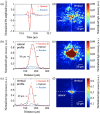High-speed photoacoustic-guided wavefront shaping for focusing light in scattering media
- PMID: 33649683
- PMCID: PMC8237830
- DOI: 10.1364/OL.412572
High-speed photoacoustic-guided wavefront shaping for focusing light in scattering media
Abstract
Wavefront shaping is becoming increasingly attractive as it promises to enable various biomedical applications by breaking through the optical diffusion limit that prevents light focusing at depths larger than ∼1mm in biological tissue. However, despite recent advancements in wavefront shaping technology, such as those exploiting non-invasive photoacoustic-guidance, in vivo demonstrations remain challenging mainly due to rapid tissue speckle decorrelation. In this work, we report a high-speed photoacoustic-guided wavefront shaping method with a relatively simple experimental setup, based on the characterization of a scattering medium with a real-valued intensity transmission matrix. We demonstrated light focusing through an optical diffuser by optimizing 4096 binary amplitude modulation modes of a digital micromirror device within ∼300ms, leading to a system runtime of 75 µs per input mode, which is 3 orders of magnitude smaller than the smallest runtime reported in literature so far using photoacoustic-guided wavefront shaping. Thus, our method is a solid step forward toward in vivo applications of wavefront shaping.
Conflict of interest statement
The authors declare that there are no conflicts of interest. T. V. is founding director and shareholder of Hypervision Surgical Ltd and holds shares from Mauna Kea Technologies.
Figures



References
-
- Mosk A. P., Lagendijk A., Lerosey G., Fink M., Nat. Photonics 6, 283 (2012).NPAHBY10.1038/nphoton.2012.88 - DOI
-
- Rotter S., Gigan S., Rev. Mod. Phys. 89, 015005 (2017).RMPHAT10.1103/RevModPhys.89.015005 - DOI
-
- Čižmár T., Mazilu M., Dholakia K., Nat. Photonics 4, 388 (2010).NPAHBY10.1038/nphoton.2010.85 - DOI
MeSH terms
Grants and funding
LinkOut - more resources
Full Text Sources
Other Literature Sources

